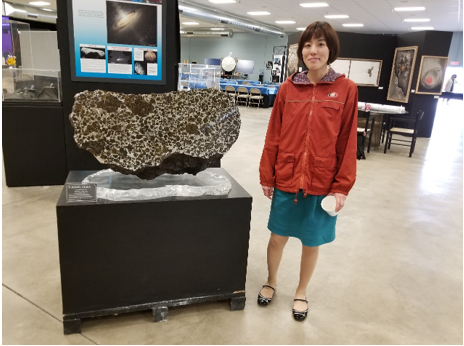Watch: Jun.13 Dr. Yoko KEBUKAWA: Formation and evolution of organic matter in the solar system and origins of life
Speaker: Yoko Kebukawa, Yokohama National University
June 13, 2022
8pm GMT+8
Primitive meteorites, such as carbonaceous chondrites contain a few wt.% organic matter. The most of organic carbon (>70 wt.%C) exists as in the form of solvent insoluble organic matter (IOM) with complex macromolecular structures. Rest of the organic carbon is in the form of solvent extractable organic compounds that include tens of thousands of different molecular compositions, with possibly millions of diverse structures. Some of them, such as amino acids and nucleobases could have been contributed to the emergence of life in the early earth. How were these diverse meteoritic organics produced and evolved? It may track back to death of stars. A molecular cloud was formed from materials that were ejected from stellar sources such as a supernova (the explosion of a star). In the very low temperature (~10-50 K) molecular cloud, chemical reactions would be driven by UV photons and cosmic rays in the ice mantles on the silicate dust grains.
Laboratory experiments showed that various organic molecules including amino acids were produced by UV or particle irradiations to ices that consist of simple molecules such as H2O, CO and CH3OH. Then the molecular cloud collapsed by its gravity and the young sun formed. Small bodies accreted from remaining gas and dust. Internal heating of the small bodies containing icy dust turned ice into aqueous solution. Chemical reactions involving liquid water caused alteration and formation of organic matter. Such chemical processes played important roles for the final composition and structure of complex organic matter in the primitive meteorites. We have been experimentally simulated aqueous processes in the planetesimals. Our studies showed that amino acids would formed simultaneously with complex macromolecular organic solids. We are also trying to understand chemical processes by studying organic matter in meteorites.
About the Speaker

I received Ph.D. for science in Department of Earth and Space Science, Osaka University in 2009. I worked at Geophysical Laboratory, Carnegie Institution of Washington. After working at Department of Natural History Sciences, Hokkaido University, I joined faculty as an associate professor at Faculty of Engineering, Yokohama National University. My research interests are organic matter in extraterrestrial materials and its roles in the early Solar System history and origins of life, particularly organic chemistry in small bodies in the Solar System. I have been studying organic matter in meteorites using various analytical methods including Fourier transform infrared spectroscopy (FTIR) and scanning transmission. X-ray microscopy (STXM), as well as experimental simulations and kinetic studies for formation and evolution of organic matter. I also contribute to Tanpopo mission that is an ongoing Japanese astrobiology project using ISS experimental module, and I am a member of the initial analysis team of the asteroid Ryugu samples returned by Hayabusa 2 mission.
Sign up to the ISSI-BJ Newsletter or follow us on WeChat (ISSIBJ)
to be always up-to-date and to not miss our seminars!


